
Narthecium ossifragum (*)
Classification System: APG IV
Superregnum: Eukaryota
Regnum: Plantae
Cladus: Angiosperms
Cladus: Monocots
Ordo: Dioscoreales
Familia: Nartheciaceae
Genus: Narthecium
Species: Narthecium ossifragum
Name
Narthecium ossifragum (L.) Huds., Fl. Angl.: 128. 1762.
Synonyms
Basionym
Anthericum ossifragum L., Sp. Pl. 1: 311. 1753.
Homotypic
Abama ossifraga (L.) DC. in J.B.A.M.de Lamarck & A.P.de Candolle, Fl. Franç. 3: 171. 1805.
Anthericum palustre Salisb., Prodr. Stirp. Chap. Allerton: 250. 1796, nom. superfl.
Phalangium ossifragum (L.) Muhl. ex Steud., Nomencl. Bot., ed. 2, 2: 184. 1841.
Tofieldia ossifraga (L.) Chaub., Actes Soc. Linn. Bordeaux 19: 228. 1853.
Heterotypic
Narthecium anthericoides Hoppe ex Mert. & W.D.J.Koch in J.C.Röhling, Deutschl. Fl., ed. 3, 2: 559. 1826.
Narthecium palustre Bubani, Fl. Pyren. 4: 169. 1902.
References
Govaerts, R. et al. 2011. Narthecium ossifragum in World Checklist of Selected Plant Families. The Board of Trustees of the Royal Botanic Gardens, Kew. Published on the internet. Accessed: 2011 Nov 04. Reference page.
USDA, ARS, Germplasm Resources Information Network. Narthecium ossifragum in the Germplasm Resources Information Network (GRIN), U.S. Department of Agriculture Agricultural Research Service. Accessed: 28-Oct-07.
Vernacular names
Deutsch: Moorlilie
suomi: Suolilja
français: Narthécie des marais
magyar: Közönséges lápcsillag
Nederlands: Beenbreek
Narthecium ossifragum, commonly known as bog asphodel,[1] Lancashire asphodel or bastard asphodel,[2] is a species of flowering plant in the family Nartheciaceae. It is native to Western Europe, found on wet, boggy moorlands up to about 1,000 m (3,300 ft) in elevation. It produces spikes of bright yellow flowers in summer. The bright orange fruits have been used as a colourant to replace saffron by Shetland Islanders.[3] Despite the plant's English name "bog asphodel", it is not particularly closely related to the true asphodels. In addition to other forms of pollination, this plant is adapted to rain-pollination.[4] The Latin specific name ossifragum means "bone-breaker", and refers to a traditional belief that eating the plant caused sheep to develop brittle bones. The probable origin of this story is that sheep eating a calcium-poor diet are likely to develop bone weakness, and N. ossifragum favours acidic low-calcium soils.[3]
Description
Bog asphodel is a tufted, hairless herbaceous perennial with a creeping rhizome. The leaves are up to 6 in (15 cm) long, narrow, flattened and sword-shaped, and often tinged with orange. The inflorescence is a spike with bright yellow, star-like flowers about 0.7 in (18 mm) across, which have short white hairs on the orange stamens. The fruits are deep orange.[5][6]
Biology
The plant can cause photosensitisation, a serious skin condition of sheep called alveld, "elf fire", in Norway. It can be relieved by moving stock into the shade. Not all stands of the plant are toxic, and the toxicity may be the side effect of the plant's response to a fungal infection.[7][8][9]
Distribution and habitat
Bog asphodel has a circumboreal temperate oceanic distribution. In the British Isles it occurs in Scotland, Northwest England, Wales, Southwest England and most of Ireland. It grows in wet soils and peats, in bogs, wet heaths and flushes.[10] It can be found in purple moor grass and rush pastures.[2]
References
BSBI List 2007 (xls). Botanical Society of Britain and Ireland. Archived from the original (xls) on 2015-06-26. Retrieved 2014-10-17.
"Pacific Bulb Society | Narthecium". pacificbulbsociety.org. Retrieved 2017-02-23.
Richard Mabey Flora Britannica
Hagerup, O. 1950. Rain-pollination. I kommission hos E. Munksgaard. Retrieved 26 May 2018.
McClintock, David; Fitter, R.S.R. (1961). The Pocket Guide to Wild Flowers. London: Collins. p. 201.
Sterry, Paul (2006). Complete British wild flowers. London: Collins. ISBN 978-0-00-720469-4.
Handbook of Plant and Fungal Toxicants by J. P. Felix D'Mello
George B. B. Mitchell, 'Non-parasitic skin diseases of sheep' In Pract., Vol. 10, Issue 2, 69-73, March 1, 1988
Arne Flåøyen, 'Studies on the aetiology and pathology of alveld'
"Narthecium ossifragum". Online Atlas of the British and Irish Flora. Retrieved 12 March 2020.
Retrieved from "http://en.wikipedia.org/"
All text is available under the terms of the GNU Free Documentation License

